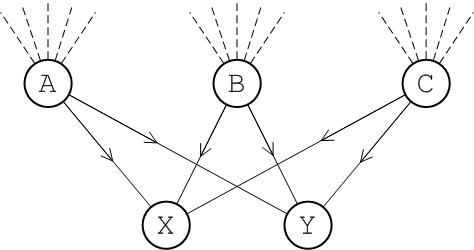-
Language:
English
-
Language:
English
9.2. Managing Producer Load
Overview
For greater scalability on the producer side, you might want to spread the message load across multiple brokers. For the purpose of spreading the load across brokers, one of the most useful topologies is the concentrator topology.
Concentrator topology
Figure 9.3, “Load Balancing with the Concentrator Topology” illustrates a two layer network arranged in a concentrator topology.
Figure 9.3. Load Balancing with the Concentrator Topology

The two layers of brokers manage the producer load as follows:
- The first layer of brokers, A, B, and C, accepts connections from message producers and specializes in receiving incoming messages.
- The second layer of brokers, X and Y, accepts connections from message consumers and specializes in sending messages to the consumers.
With this topology, the first layer of brokers, A, B, and C, can focus on managing a large number of incoming producer connections. The received messages are consolidated within the brokers before being passed through a relatively small number of network connectors to the second layer, X and Y. Assuming the number of consumers is small, the brokers, X and Y, only need to deal with a relatively small number of connections. If the number of consumers is large, you could add a third layer of brokers to fan out and handle the consumer connections.
Client configuration
When connecting to a broker network laid out in a concentrator topology, producers and consumers must be configured to connect to the brokers in the appropriate layer. In the case of a producer connecting to the concentrator topology shown in Figure 9.3, “Load Balancing with the Concentrator Topology”, producers should connect to the brokers in the first layer: A, B, and C. Consumers should connect to the brokers in the second layer: X and Y.

